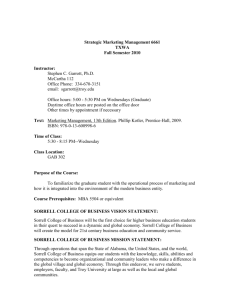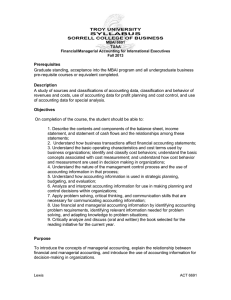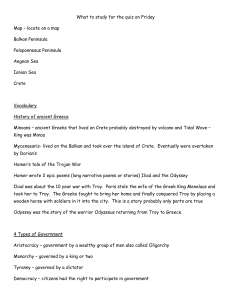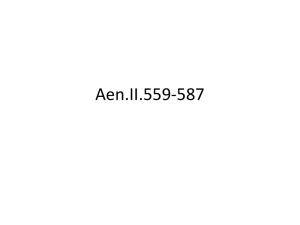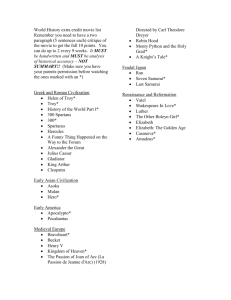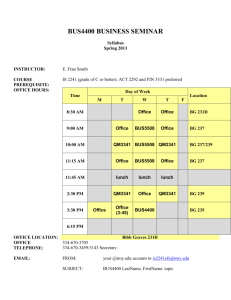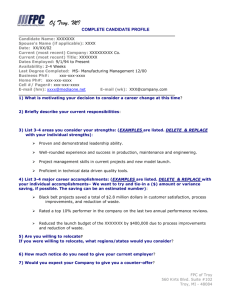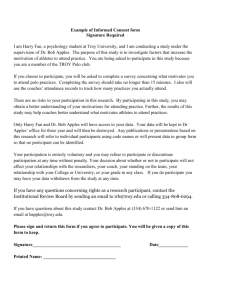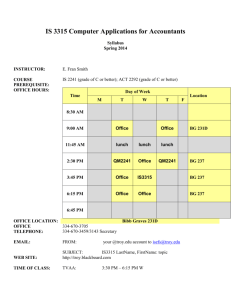qm 2241 business statistics - the Sorrell College of Business at Troy
advertisement
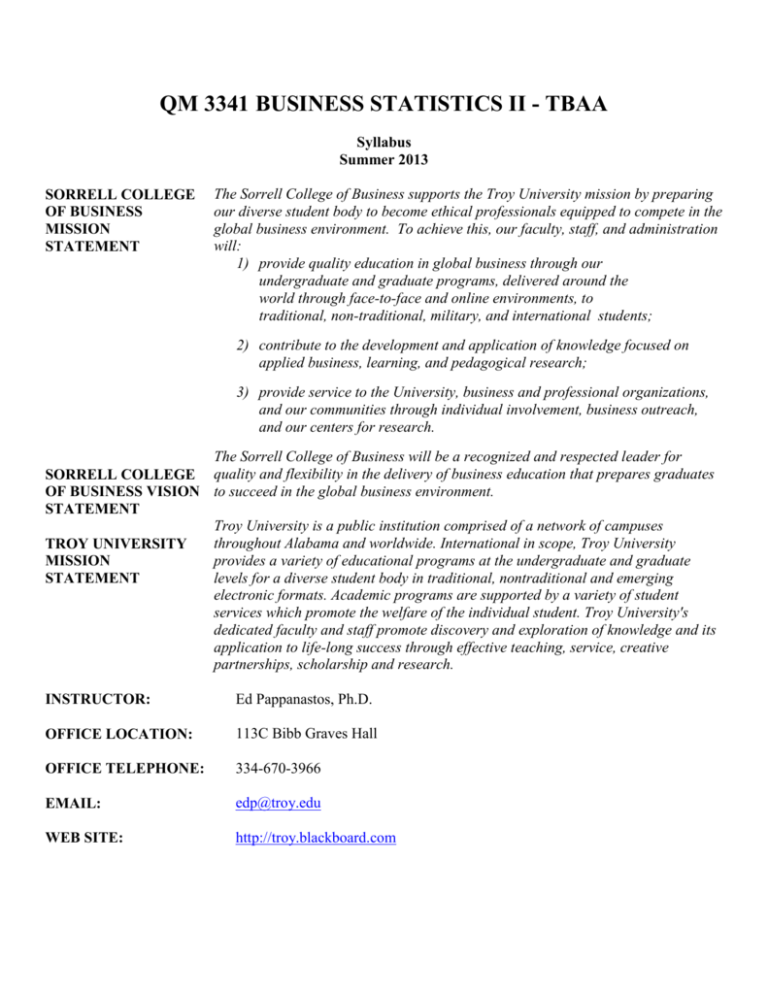
QM 3341 BUSINESS STATISTICS II - TBAA Syllabus Summer 2013 SORRELL COLLEGE OF BUSINESS MISSION STATEMENT The Sorrell College of Business supports the Troy University mission by preparing our diverse student body to become ethical professionals equipped to compete in the global business environment. To achieve this, our faculty, staff, and administration will: 1) provide quality education in global business through our undergraduate and graduate programs, delivered around the world through face-to-face and online environments, to traditional, non-traditional, military, and international students; 2) contribute to the development and application of knowledge focused on applied business, learning, and pedagogical research; 3) provide service to the University, business and professional organizations, and our communities through individual involvement, business outreach, and our centers for research. The Sorrell College of Business will be a recognized and respected leader for SORRELL COLLEGE quality and flexibility in the delivery of business education that prepares graduates OF BUSINESS VISION to succeed in the global business environment. STATEMENT Troy University is a public institution comprised of a network of campuses throughout Alabama and worldwide. International in scope, Troy University TROY UNIVERSITY provides a variety of educational programs at the undergraduate and graduate MISSION levels for a diverse student body in traditional, nontraditional and emerging STATEMENT electronic formats. Academic programs are supported by a variety of student services which promote the welfare of the individual student. Troy University's dedicated faculty and staff promote discovery and exploration of knowledge and its application to life-long success through effective teaching, service, creative partnerships, scholarship and research. INSTRUCTOR: Ed Pappanastos, Ph.D. OFFICE LOCATION: 113C Bibb Graves Hall OFFICE TELEPHONE: 334-670-3966 EMAIL: edp@troy.edu WEB SITE: http://troy.blackboard.com OFFICE HOURS: MTWTH: 1:00-2:45 p.m. TIME OF CLASS: 10:30 – 12:50 MTWTH CLASS LOCATION: BG 237 COURSE PREREQUISITE: QM 2241 (grade of “C” or better) A continuation of basic business statistics. Topics include comparison involving COURSE DESCRIPTION: means and proportions, ANOVA, simple linear regression and correlation, multiple linear regression, chi-squared applications, and nonparametric methods. Prerequisite: QM 2241. On completion of the course, the student should be able to: COURSE OBJECTIVES: 1. Apply statistical hypothesis-testing and estimation for one or more populations, and interpret the results. 2. Apply ANOVA procedures to sample data, and interpret the results. 3. Apply simple and multiple linear-regression techniques and correlation analysis to sample data, and interpret the results. 4. Identify when the assumptions of parametric tests are violated and when nonparametric methods must be applied. 5. Conduct nonparametric tests on sample data, and interpret the results. 6. Discuss the limitations of statistical analysis. 7. Use statistical software for data analysis. PURPOSE: To develop advanced statistical-analysis skills appropriate for entry-level employment in business fields. Core requirement for all undergraduate business programs. Numbered QM 2242 prior to Fall 2005. TEXTBOOK: Statistical Techniques in Business & Economics, Lind, Marchal andWathen, McGraw-Hill, 15th edition (2012). OTHER MATERIALS: Connect Access code (packaged with new textbook or purchased separately this may be used by one student only for up to a year) CLASS PROCEDURE AND REQUIREMENTS: This course will be delivered in a lecture/discussion format. Use of MS Excel to solve problems will be demonstrated. Telephones and beepers must be turned off prior to entering the classroom. GRADING METHODS & EXAMINATIONS: There will be 4 exams including the final exam. These will primarily be problem oriented. Exams may be paper-based or may be given online. You will be told prior to examination what materials you will be allowed to bring to each exam. YOU WILL NOT BE ALLOWED TO SHARE MATERIALS. TRANSLATORS, TEXT CALCULATORS AND PHONE CALCULATORS MAY NOT BE USED. In addition to the in-class exams, students will have to complete the homework using the web-based software program, Connect+. Your Connect+ Homework grade will be as the average percent correct for chapters completed by the due date. Some assignments will contain multiple questions. Your score for an assignment will be the total points for the assignment divided by the total points possible for the assignment. You will be allowed to work the problems multiple times, and I will keep the highest score. Since some students do not have online access at home and must use our lab facilities, failure of your home equipment/ISP will not be considered an excuse for late assignments. Final grades will be calculated as a weighted average as follows: Connect+ Homework and quizzes: 20% Exam 1 – Chapter 9 & 10 10% Exam 2 – Chapters 11 and 12 (ANOVA-oneway) 20% Exam 3 – Chapters 17, one sample variance test, and two and three sample variance tests 20% Final –Chapters 13, 14 and 16 (if time permits) 30% Note: Content may change some, but the exams and weights will stay constant. The student's final grade will be determined using the traditional grading scale (A: 90-100, B: 80-89, C: 70-79, D: 60-69, F: Below 60). No tests will be dropped, no exams will be given less emphasis and no additional work will be given to boost final grades. All grades will be earned -NOT given. If you need a particular grade in this class to graduate, keep a scholarship, be eligible for sports, etc..., then you will need to score high enough to earn the grade. Again, students should plan for computer failure by completing Connect work ahead of schedule. ATTENDANCE: Attendance will be taken at the beginning of the term for reporting to Financial Aid. STUDENT RESPONSIBILITIES: Students are expected to: 1. Punctually attend all scheduled classes. 2. Be responsible for all instructions and assignments given in class as well as for the supporting textbook content. 3. Read the textbook material before the lecture covering that material and attempt the suggested problems before the material is covered in class. This leads to a better understanding of the lecture (or lab) as well as the opportunity to ask questions about material(s) in the text that was unclear or that the student did not understand. 4. You are expected to be an active participant in this class. INCOMPLETE/MISSED WORK POLICY: GENERAL SUPPORTS: CHEATING POLICY: Any student with a valid excuse for a missed exam will be allowed to make up the exam at some date and time convenient to the instructor. Except in emergencies as outlined in the student handbook, exams must be taken prior to absence. The Bibb Graves 225 Lab is available for student use when other classes are not in session. Hours are posted on the door to the lab. It is expected that students will abide by the Honor Code, Academic Code, Technology Use Policy, and Standards of Conduct as outlined in the most current version of the Oracle, the student handbook. Any student not abiding by these codes/policies/standards will be subject to the penalties outlined in the Oracle. AMERICANS WITH DISABILITIES ACT: ADDITIONAL SERVICES COURSE OUTLINE AND DATES TO REMEMBER: Troy University supports Section 504 of the Rehabilitation Act of 1973 and the Americans with Disabilities Act of 1990, which insure that postsecondary students with disabilities have equal access to all academic programs, physical access to all buildings, facilities and events, and are not discriminated against on the basis of disability. Eligible students, with appropriate documentation, will be provided equal opportunity to demonstrate their academic skills and potential through the provision of academic adaptations and reasonable accommodations. Further information, including appropriate contact information, can be found at the link for Troy University’s Office of Human Resources at http://www.troy.edu/humanresources/ADAPolicy2003.htm DATE: June 26th June 27th July 1st July 2nd July 3rd July 8th July 9th July 10th WEEK # MATERIAL COVERED 1 Syllabus, Roll, Connect, Review Chapters: 1-10 Review Chapter 10 2 Exam 1: Chapter 9 & 10, Chapter 11 Chapter 11 Chapter 11, Chapter 12: one-way ANOVA 3 Chapter 12: one-way ANOVA Chapter 12: one-way ANOVA , TUKEY Chapter 12 Review Chapter 11 July 11th July 15th July 16th July 17th July 18th July 21st July 22nd July 23rd July 24th ELECTRONIC DEVICES POLICY 4 5 Exam 2: Chapter 11, 12, TUKEY, Chapter 17 Chapter 17 Chapter 17 and Variance Testing Variance Testing Exam 3 Review; Exam 3: Chapter 17 and Variance Testing Chapter 13 Chapter 13 and Chapter 14 Chapter 14 Final Exam Review; Final Exam on 13 and 14 Per TROY Academic Operating Policy 8-1-07-08 (See http://www.troy.edu/academics/aop/documents/AOP_08-01-07-08.pdf) Use of any electronic devise by students in the instructional environment is prohibited unless explicitly approved on a case-by-case basis by the instructor of record or by the Office of Disability Services in collaboration with the instructor. Cellular phones, pagers, and other communication devices may be used for emergencies, however, but sending or receiving non-emergency messages is forbidden by the University. Particularly, use of a communication device to violate the Troy University “Standards of Conduct” will result in appropriate disciplinary action (See pp. 42-52 of the Oracle. In order to receive emergency messages from the University or family members, the call receipt indicator of devices must be in the vibration mode or other unobtrusive mode of indication. Students receiving calls that they believe to be emergency calls must answer quietly without disturbing the teaching environment. If the call is an emergency, they must move unobtrusively and quietly from the instructional area and notify the instructor as soon as reasonably possible. Students who are expecting an emergency call should inform the instructor before the start of the instructional period.
